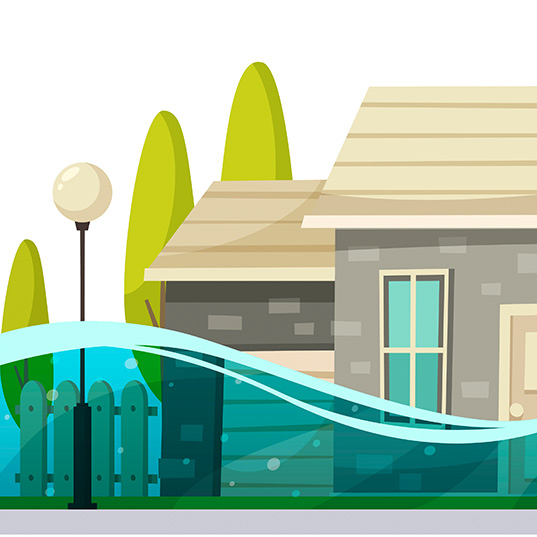The water basin in the sky: atmospheric rivers
The number of atmospheric rivers is increasing. And, with them, the risk of torrential rains and flooding. Chile has seen this in its streets. We discuss the phenomenon below.
There are rivers flowing miles high, floating in the air and blown around by the wind. They don’t run across land, contain liquid water or feed into the sea. Called atmospheric rivers, they are long masses of water vapor, transformed into torrential rain causing flooding, electricity outages and other problems getting worse with climate change. Below we tell you about atmospheric rivers and why they are increasingly in the news in many regions of the planet.
What will I learn from this article?
Atmospheric rivers flowing in the sky
In the atmosphere, there are extensive quantities of water in the gaseous state. It is what we know as water vapor, found in its most concentrated form in the tropics due to their high temperatures and humidity. In places like the Atacama Desert, for example, there are hardly any such ‘rivers’, i.e. water vapor does not distribute equally across the planet. It does move, though, managing to travel hundreds of miles above our heads.
 These flows constitute what are known as atmospheric rivers. They are thin and long and carry water like the rivers we know on land. The difference is that atmospheric rivers carry highly concentrated water vapor. “In fact, when you calculate the water they transport, in many cases they are comparable to large rivers, such as the Puelo, Baker or Amazon rivers,” explains René Garreaud, director of CR2, the Climate and Resilience Science Center, in this talk on the subject, organized by PrensaCR2.
These flows constitute what are known as atmospheric rivers. They are thin and long and carry water like the rivers we know on land. The difference is that atmospheric rivers carry highly concentrated water vapor. “In fact, when you calculate the water they transport, in many cases they are comparable to large rivers, such as the Puelo, Baker or Amazon rivers,” explains René Garreaud, director of CR2, the Climate and Resilience Science Center, in this talk on the subject, organized by PrensaCR2.
Experts say they are the main water carriers from the tropics to other latitudes. When they touch Earth, they often free this water vapor in the form of rain or snow. So their role in the global water cycle is very important.
According to the amount of water they transport, they are classified as “weak” to “exceptional”. The scale goes from Category 1 – short-duration or low-level atmospheric rivers – to Category 5, which flow very intensely fast, or moderately longer.
Atmospheric rivers overwhelm Chile
The concept of atmospheric rivers is known to Chileans. In June, the country experienced its heaviest rains in 30 years, recorded over its central and southern regions: rainfall that left two people dead, three disappeared and around 10,000 stranded in rural areas.
The intense rainfall caused an emergency, but also respite from a mega-drought that was pounding central Chile, the longest and most serious in a thousand years according to the World Meterological Organization Latin America and Caribbean Climate Report.
“In June, Chile experienced its heaviest rains in 30 years”
California in the United States underwent a similar episode with more than 10 storms caused by atmospheric rivers in the same season. In March 2023, California Governor Gavin Newsom declared a state of emergency in 21 counties and requested a Presidential Declaration of Emergency for the authorization of federal aid due to the risk of floods as a result of this phenomenon.
And, in Spain, the city of Zaragoza was subject to extraordinary torrential rain, a storm which weather forecasters qualified as historic (54 liters per hour and square meter, with peaks of more than 100 liters in 10 minutes) and resulted in powerful and quite incredible images.
Buildings and roads flooded, cars washed away as catastrophic flash floods hit Spain's Zaragoza
— Earth42morrow (@Earth42morrow) July 6, 2023
VC: @Soniatwin72#Floods #Storm #Spain #Zaragoza #Venecia #Flooding #Granizo #Tormento #FlashFloods #Viral #Weather #Climate pic.twitter.com/PxOzIzHnbM
“Buildings must be resilient and conceived with the environment into mind more than ever before, because extreme phenomena are now increasingly common,” Ángel Pueyo, Professor of Geography at Zaragoza University, told La Ser (see this article in El País).
“Buildings must be resilient and conceived with the environment in mind more than ever before, because extreme phenomena are now increasingly common”
It is important to note that not all atmospheric rivers are destructive. Most are weak systems which often lead to rain or snow vital for water supplies.
But images of overflowing rivers, collapsing bridges, unpassable roads and closed borders invite us to reflect upon the importance of resilient infrastructure as climate change makes such events more common and intense.
Building a world today, able to resist climate change tomorrow
Ever more cities worldwide are seeking ways of building resilient infrastructure to respond to the consequences of climate change. Systems designed not only with the aim of covering present needs, but also able to adapt to tomorrow’s requirements.
Atmospheric rivers have been causing extreme rainfall in various parts of the world. In this context, resilient infrastructure is a model we can follow in adapting to increasingly common extreme climate events.
The Fargo-Moorhead anti-flood canal, is a good example, recipient of a PFI Award in 2021 and which stretches between Fargo, North Dakota, and Moorhead, Minnesota, in the United States.
The canal was built to respond strategically and in advance to future flooding. ACCIONA, in charge of the construction and operation of the canal, designed a 48-kilometer-long system diverting water and protecting local communities.
The project includes a series of infrastructures such as dams, canals, bridges and other structures to control possible future flooding of the river. It also provides for the restoration of natural areas and wetlands in the area. Once completed, it will protect over 235,000 people in the main population centers between Fargo and Moorhead.
As the frequency and intensity of these events continues to increase, the need for resilient and adaptive infrastructure such as the Fargo-Moorhead canal is becoming more urgent. This pioneering project shows how engineers and planners can work together to protect our cities and communities from the growing threat of climate change.
Sources:


